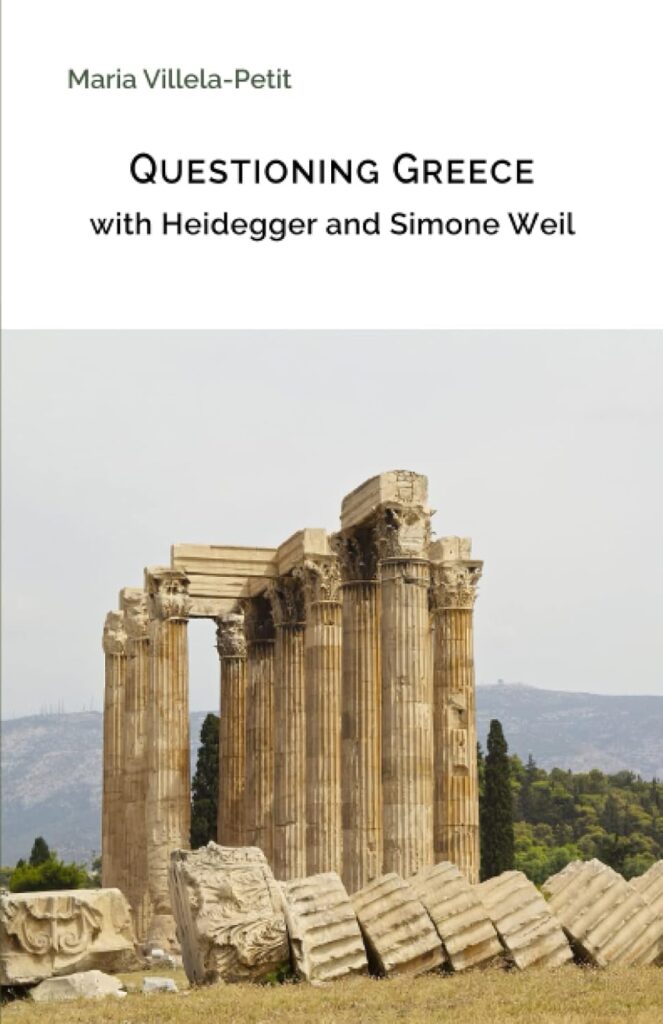Maria Villela-Petit on Weil and Sophocles
Maria Villela-PetitThe following excerpts are taken from Maria Villela-Petit’s
Questioning Greece with Heidegger and Simone Weil (John S. O’Leary, ed. & trans.: Nagoya, Japan: Chisokudo, 2023), pp. 66-68.
. . . In May, 1942, when Simone Weil wrote in Marseille, her essay, “Formes de l’amour implicite de Dieu” she approached Elektra’s behavior under the angle of waiting: “Elektra does not search for Orestes; she awaits him.” This idea leads her to see in Elektra’s waiting an image of the soul that waits on God: “One to whom Elektra’s adventure has happened, who has seen, heard, and touched, with the soul itself, such a one will recognize in God the reality of those indirect loves that were as reflections” (OC IV/I, 335).

Simone Weil translated the scene of Sophocles’ Elektra (vv, 1218-29), in which Elektra at last recognizes Orestes, placing it precisely under the heading, “Recognition of God and Man” in Intuitions pré-chrétiennes(OC IV/2, 156-7). Her annotations of this tragedy in the Cahiers already show the cardinal role she gave to recognition, a notion that has stimulated important philosophical reflection in the German idealist and in contemporary philosophy, and that underlies what Simone Weil understands by reading. “Recognition is reading,” she writes. That proposition, merits reflection, for it is the very thing that allows her to bring about rapprochements and discern concordances. Reading here does not mean what one usually thinks of as a hermeneutical approach, but rather focuses on recognizing likenesses, resemblances, analogies.
Her statement comes at the end of a passage in which Elektra is linked with Mary Magdalene‘s recognition of the risen, Christ: “the divinity has placed on nature the seal of similitude, a seal that allows Elektra to recognize Orestes. Stories of recognition by marks in folklore are degradations from mists that are images of the recognition of God by man. (John, 20:16)” This “metaphysical transposition,” as she calls it, of Sophocles on John, brings home to us how much the notion of recognition shapes her idea of reading and her original method of engaging literary works. What she looks for is the nuggets of gold, the burst of truth lodged in the texts, most often in the form of fragments, and that can be linked to those lodged in other works. By reading, then, she means a procedure of recognition that transgresses boundaries, and that is not confined to the discipline of philosophical or historical interpretation of the texts.

That this conception of reading also had a mystical dimension becomes undeniable when one reads this affirmation of hers, in the form of a vow:
To read God in every manifestation without exception, but according to the correct proportion of the manifestation proper to every appearance.
To know in what way each appearance is not God.
Faith, a gift of reading.
The gift of reading is supernatural, and without this gift there is no justice. (OC VI/2, 317) [The Notebooks of Simone Weil (N.Y.: G. P. Putnam’s Sons, Arthur Wills, trans., 1956), vol. I, p. 220]
We can recognize her possession of this gift in the way she reads the Greek tragedians and does justice to them.
Maria Villela-Petit, a Brazil-born Parisian philosopher, is a retired researcher at the Archives Husserl in Paris. She studied under Paul Ricœur, lectured on aesthetics at the Institut Catholique de Paris, and is an emerita researcher of the Centre national de la recherche scientifique. At Ricœur’s request, she wrote a first study on Regard Parole Espace.
Table of Contents
- Powers of Speech in the Iliad
- Kelos in Sophocles’ Philoctetes
- Modern France of Philoctetes: Kierkegaard, Gide, Fondane
- Simone Weil as Reader of Greek Tragedians
- The Ontological Status of the Artistic Image in Plato’s Sophist
- Poetry in Plato’s Republic
- Painters’ in Aristotle’s Poetics
- Heidegger, Plato, and Greek Art
- Heidegger’s Readings of Plato
- Simone Weil, Martin Heidegger, and Greece
- Heidegger as an “Idolater”?
- Simone Weil’s Elective and Analogical Reading
- Cain and Abel: A Ritual Feud

